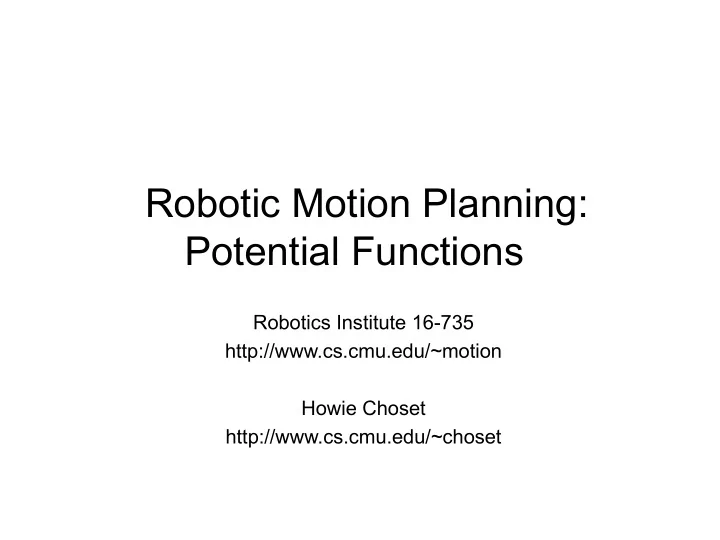

Robotic Motion Planning: Potential Functions Robotics Institute 16-735 http://www.cs.cmu.edu/~motion Howie Choset http://www.cs.cmu.edu/~choset
The Basic Idea ● A really simple idea: – Suppose the goal is a point g ∈ ℜ 2 – Suppose the robot is a point r ∈ ℜ 2 – Think of a “spring” drawing the robot toward the goal and away from obstacles: – Can also think of like and opposite charges
Another Idea ● Think of the goal as the bottom of a bowl ● The robot is at the rim of the bowl ● What will happen?
The General Idea Both the bowl and the spring analogies are ways of storing potential energy ● The robot moves to a lower energy configuration ● A potential function is a function U : ℜ m → ℜ ● Energy is minimized by following the negative gradient of the potential energy ● function: We can now think of a vector field over the space of all q’s ... ● at every point in time, the robot looks at the vector at the point and goes in that – direction
Attractive/Repulsive Potential Field – U att is the “attractive” potential --- move to the goal – U rep is the “repulsive” potential --- avoid obstacles
Artificial Potential Field Methods: Attractive Potential Conical Potential Quadratic Potential = −∇ F ( q ) U ( q ) att att = − δ k ( q ) goal
Artificial Potential Field Methods: Attractive Potential Combined Potential In some cases, it may be desirable to have distance functions that grow more slowly to avoid huge velocities far from the goal one idea is to use the quadratic potential near the goal (< d*) and the conic farther away One minor issue: what?
The Repulsive Potential
Repulsive Potential
Total Potential Function = + U ( q ) U ( q ) U ( q ) att rep = −∇ F ( q ) U ( q ) = +
Potential Fields
Gradient Descent ● A simple way to get to the bottom of a potential A critical point is a point x s.t. ∇ U(x) = 0 – Equation is stationary at a critical point – Max, min, saddle – Stability?
The Hessian ● For a 1-d function, how do we know we are at a unique minimum (or maximum)? ● The Hessian is the m × m matrix of second derivatives ● If the Hessian is nonsingular (Det(H) ≠ 0), the critical point is a unique point – if H is positive definite (x^t H x > 0), a minimum – if H is negative definite, a maximum – if H is indefinite, a saddle point
Gradient Descent Gradient Descent: – q(0)=q start – i = 0 – while ∇ U(q(i)) ≠ 0 do ● q(i+1) = q(i) - α (i) ∇ U(q(i)) ● i=i+1
Gradient Descent Gradient Descent: – q(0)=q start – i = 0 – while || ∇ U(q(i)) || > ε do ● q(i+1) = q(i) - α (i) ∇ U(q(i)) ● i=i+1
The Wave-front Planner ● Apply the brushfire algorithm starting from the goal ● Label the goal pixel 2 and add all zero neighbors to L – While L ≠ ∅ ● pop the top element of L, t ● set d(t) to 1+min t’ ∈ N(t),d(t) > 1 d(t’) ● Add all t’ ∈ N(t) with d(t)=0 to L (at the end) ● The result is now a distance for every cell – gradient descent is again a matter of moving to the neighbor with the lowest distance value
The Wavefront Planner: Setup
The Wavefront in Action (Part 1) Starting with the goal, set all adjacent cells with “0” to the current cell + 1 ● 4-Point Connectivity or 8-Point Connectivity? – Your Choice. We’ll use 8-Point Connectivity in our example –
The Wavefront in Action (Part 2) Now repeat with the modified cells ● This will be repeated until no 0’s are adjacent to cells with values >= 2 – 0’s will only remain when regions are unreachable ●
The Wavefront in Action (Part 3) Repeat again... ●
The Wavefront in Action (Part 4) And again... ●
The Wavefront in Action (Part 5) And again until... ●
The Wavefront in Action (Done) You’re done ● Remember, 0’s should only remain if unreachable regions exist –
The Wavefront, Now What? To find the shortest path, according to your metric, simply always move toward a cell with a lower ● number The numbers generated by the Wavefront planner are roughly proportional to their distance from the goal – Two possible shortest paths shown
Another Example
Wavefront (Overview) ● Divide the space into a grid. ● Number the squares starting at the start in either 4 or 8 point connectivity starting at the goal, increasing till you reach the start. ● Your path is defined by any uninterrupted sequence of decreasing numbers that lead to the goal.
Potential Fields on Non- Euclidean Spaces ● Thus far, we’ve dealt with points in R n --- what about real manipulators ● Recall we can think of the gradient vectors as forces -- the basic idea is to define forces in the workspace (which is ℜ 2 or ℜ 3 ) Power is conserved! Power in configuration space Power in work space
In General ● Pick several points on the manipulator ● Compute attractive and repulsive potentials for each ● Transform these into the configuration space and add ● Use the resulting force to move the robot (in its configuration space) AF 1 (x,y) β Be careful to use the RF 4 correct Jacobian! RF 3 L 2 RF 2 y RF 1 L 1 α x
Recommend
More recommend